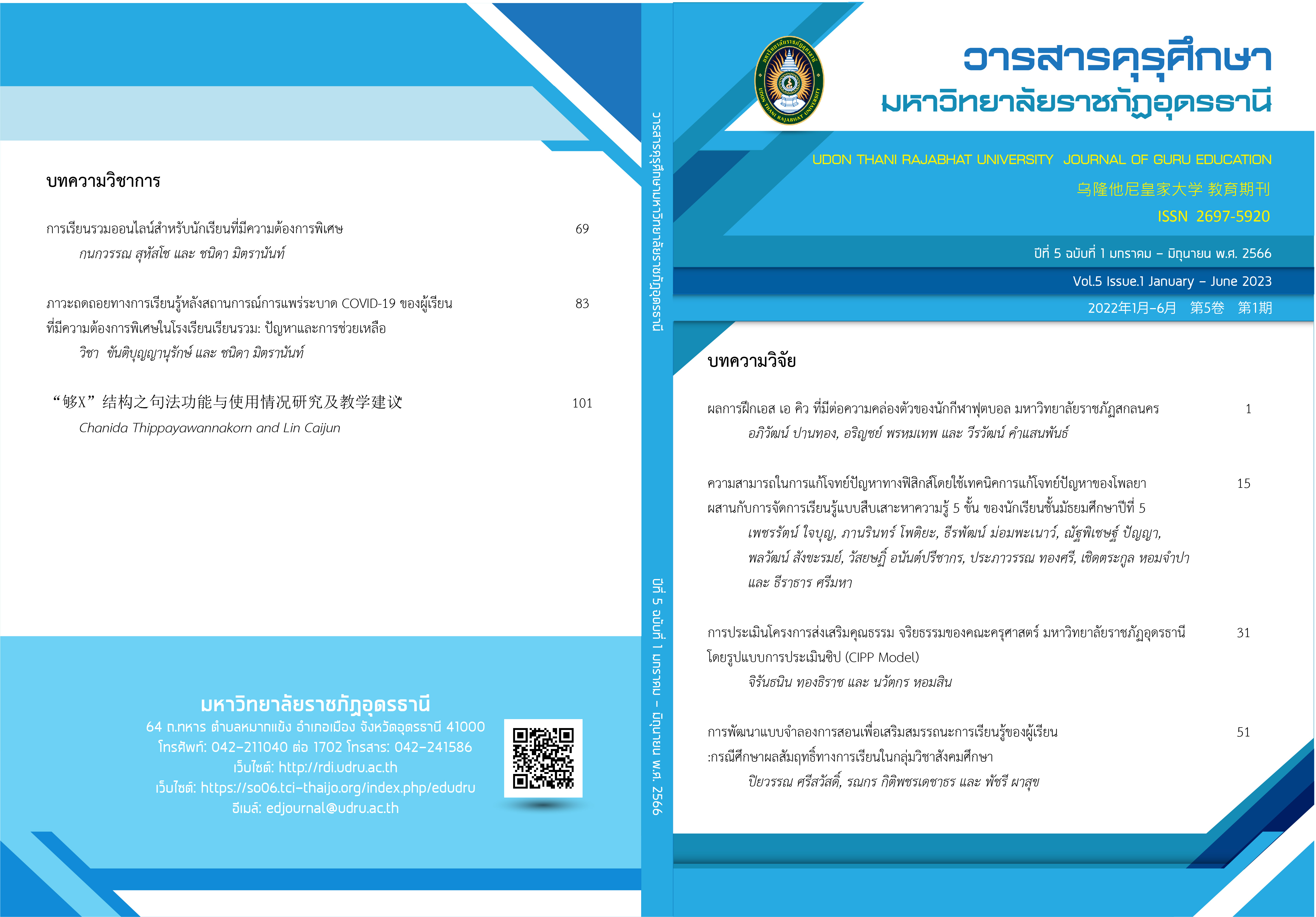A STUDY OF SYNTACTIC FUNCTION AND USAGES OF THE “GOU X” CONSTRUCTION AND ITS PEDAGOGY
Main Article Content
บทคัดย่อ
“Gou” (够) plays a crucial role in teaching Chinese as a second language, making it essential for learners to master the concept of “Gou X” construction. This study examined the syntactic function and usages of the “Gou X” construction through the analysis of the CCL Modern Chinese Corpus from Peking University. The research focused on understanding the part of speech of “Gou” and its various syntactic functions within different frameworks. The findings revealed that (1) the dictionaries and textbooks on Chinese as a foreign language have different opinions on the part of speech of the “Gou”. The part of speech of “Gou” varied based on its meaning and contextual usage. (2) The “Gou X” construction exhibited richness, complexity, and varied syntactic functions. (3) In the “Gou X” construction, the most common structural form is “Gou + monosyllabic noun”, “Gou + noun with emotional meaning”, “Gou + verb” and “Gou + adjective”. Among them, “Gou + adjective” is the most widely used. The study concluded by providing pedagogical suggestions based on the research findings.
Article Details
ข้อความที่ปรากฏในบทความแต่ละเรื่องในวารสารวิชาการเล่มนี้ ไม่ใช่ความคิดเห็นและความรับผิดชอบของคณะผู้จัดทำ บรรณาธิการ กองบรรณาธิการ และมหาวิทยาลัยราชภัฏอุดรธานี ซึ่งความรับผิดชอบด้านเนื้อหาและการตรวจร่างบทความแต่ละเรื่องเป็นของผู้เขียนแต่ละท่าน
เอกสารอ้างอิง
Cao, X. Z. & Su, P. C. (2007). Xinhua Duogongneng Zidian. Beijing: The Commercial Press. [in Chinese]
Chen, B. & Zhu, Z. P. (2004). Learn Chinese with Me. Beijing: People's Education Press. [in Chinese]
Deng, Y. (2003). The Primary Textbooks of Spoken Chinese as a Foreign Language. Beijing: Peking University Press. [in Chinese]
Gu, L. F. (2016). A Study of the Usage of “Gou” and Teaching Chinese as a Foreign Language. Modern Chinese, 9, 105-107. [in Chinese]
Guo, R. (2002). A Study of the Word Class System in Modern Chinese. Beijing: The Commercial Press. [in Chinese]
Huang, B. R. & Liao, X. D. (2007). Modern Chinese. Beijing: Higher Education Press. [in Chinese]
Huang, Z. C. (2000). A New Chinese Course Book. Beijing: China International Book Trading Corporation. [in Chinese]
Kang, Y. H. & Lai, S. P. (2005). Conversational Chinese 301. Beijing: Beijing Language and Culture University Press. [in Chinese]
Lado, R. (1957). Linguistics Across Cultures. Ann Arbor: University of Michigan Press.
Li, X. J. (1998). Xiandai Hanyu Guifan Zidian. Beijing: Language and Culture Press. [in Chinese]
Li, X. Q. (2005). Boya Chinese. Beijing: Peking University Press. [in Chinese]
Li, X. Q. & Dai, G. Y. & Guo, Z. H. (2000). A new perspective: Context, Function and Structure in Teaching Chinese. Beijing: Peking University Press. [in Chinese]
Li, X. Q., Liu, D. L., M, S. Y., Liu, Y. M. & Yang, D. F. (2002). Hanyu Changyongci Yongfa Cidian. Beijing: Peking University Press. [in Chinese]
Li, Y. M. (1997). A Dictionary of Modern Chinese Usage Beijing: Beijing Language and Culture University Press. [in Chinese]
Liu, D. L. & Zhang, Y. (2007). New Concept Chinese. Beijing: Peking University Press. [in Chinese]
Liu, X. (2007). New Practical Chinese Reader Textbook. Beijing: Beijing Language and Culture University Press. [in Chinese]
Luo, Q. S. (1995). Analysis of the Grammatical Features of the Adverb “Gou”. Yindu Journal, 1, 98-101. [in Chinese]
Lyu, S. X. (1980). Modern Chinese Eight Hundred Words (revised edition). Beijing: The Commercial Press. [in Chinese]
Qi, H. Y., Zhang, Y. S. & Chen, C. L. (2002). Xiandai Hanyu Xuci Yanjiu Zongshu. Hefei: Anhui Education Publishing House. [in Chinese]
Shen, J. H. (2001). The “Gou + adjective” Phrase Falls into Two Categories According to the Different Positions of Stress. Chinese Teaching in the World, 3, 34-40. [in Chinese]
Su, K. (1999). Reclassification of the Verb “Gou” + Noun. Journal of Jiangsu Radio and Television University, 1, 51-52. [in Chinese]
The College of Intensive Chinese Training at Beijing Language and Culture University. (2006). Sucheng Hanyu Chuji Jiaocheng. Beijing: Beijing Language and Culture University Press. [in Chinese]
The Dictionary Editing Room of Institute of Linguistics, CASS. (2016). Xiandai Hanyu Cidian(7th). Beijing: The Commercial Press. [in Chinese]
The Editorial Department of Zhonghua Book Company. (2000). Zhonghua Cidian. Beijing: Zhonghua Book Company. [in Chinese]
The Test Center of Beijing Language and Culture University. (2000). A dictionary of Chinese usage: 8000 words. Beijing: Beijing Language and Culture University Press. [in Chinese]
The Test Center of Beijing Language and Culture University. (2003). Zhongguo Hanyu Shuiping Kaoshi Dagang (Jichu). Beijing: Modern Press. [in Chinese]
Wang, Q. J. (2007). Talk about “Verb + Gou”. Modern Chinese, 4, 42-43. [in Chinese]
Wang, Q. J. (2007). A Study of the Pattern of “Verb + Gou” and “Gou + Verb”. Master's Thesis, Shanghai Normal University. [in Chinese]
Yang, J. Z. (2009). Hanyu Jiaocheng. Beijing: Beijing Language and Culture University Press. [in Chinese]
Yu, G. Y. (1991). Adverb + Noun. Language Planning, 1, 19-22. [in Chinese]
Zhao, L. J. (1998). The Preliminary Investigation on the Use of “Gou”. Chinese Language Learning, 3, 52-54. [in Chinese]
Zhao, Y. R. (1979). A Grammar of Spoken Chinese. Beijing: The Commercial Press. [in Chinese]
Zhou, X. B. (1995). The Sentence Pattern of “Gou + Adjective”. Chinese Language Learning, 6, 31-33. [in Chinese]
Zhou, X. B. (1996). “Gou + Verb / Clause”. Yuwen Yuekan, 9, 17-18. [in Chinese]
Zhu, D. X. (1982). Lectures on Grammar. Beijing: The Commercial Press. [in Chinese]


